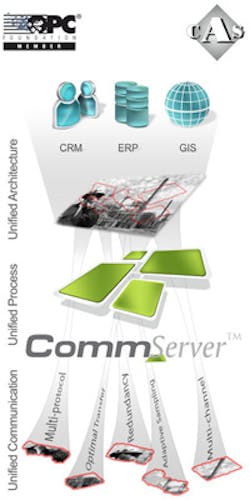3 Steps to OPC UA: Model, Bind and Run
One of the main goals of the OPC Unified Architecture is to expose information that can be used by clients to manage an underlying real-time process and the entire business enterprise as a whole. The main challenges include integrating the automation systems (e.g. programmable logic controllers—PLCs, distributed control systems—DCSs and SCADA systems) and the business management systems (e.g. ERP, MES, GIS) into one homogenous environment. Clients usually need only a select part of the available information at any time. To meet this requirement, the published information must be well organized and selectively available as addressable entities called nodes. The collection of these nodes exposed by the OPC UA Server is called the Address Space, and the description of the Address Space organization is called the Information Model.Step 1: Design the Information ModelThe first step in achieving OPC UA connectivity is to design the Information Model using the CAS Address Space Model Designer. The CAS Unified Architecture Address Space Model Designer (ASMD) is a software tool intended to help architects, engineers and developers accomplish this task. This tool supports all aspects of the model designing process including edition, visualization and, finally, generation of files, allowing the server to expose real-time process metadata.With hundreds of thousands of OPC Classic applications already installed, it’s important to consider the OPC migration path. ASMD provides support in bridging applications because it offers Address Space import capabilities from any OPC Data Access (DA) server. The main advantage of this approach is that the obtained model can be freely modified to meet vendor or process needs. Publishing the information using the OPC UA Address Space needs to address the question of how to get access to underlying process data.Step 2: Binding the Address Space Nodes to Process Data SourcesThe second step in achieving OPC UA connectivity is binding of the Address Space nodes to process data sources using the CAS Address Space Model Designer. Process data access is application and vendor specific, and to be established it must work in the context of the Information Model. ASMD meets this challenge by offering a rich collection of supporting features and very flexible architecture using vendor-developed plug-ins that implement necessary proprietary functions. This approach makes the data access configuration design tightly coupled with the Information Model design process.Accompanying the UA application, ASMD is a tool that allows users to take the first two steps towards obtaining OPC UA connectivity. These first two steps comprise the development stage of any OPC UA application. At run time, the Information Model and process data bindings are to be utilized to manage data transfer.Step 3: Instantiate the Address Space and Couple It to Data Using CommServerThe third step to obtain OPC UA connectivity is instantiation of the Address Space according to the Information Model and coupling it with real data using the CommServer communication engine. The CommServer multi-source redundant communication engine is a self-contained software package that can be seamlessly adopted to be used by any selected communication stack. Previously, the CommServer was offered with an OPC DA interfaces set (self tested) and now it is also available with the OPC UA communication stack.CommServer offers the following data sources:- Multiprotocol communication server—Any vendor specific protocol can be implemented using a Rapid Development Kit (available for free), if not available off-the-shelf.- OPC DA client—Any OPC DA server can be wrapped and bonded with a freely developed Information Model.- Simulator—Process-specific algorithms can be implemented and used at the development stage instead of real data, or at run time as the state observer output.All three steps can be accomplished without programming.Learn more about modeling, binding and running.For more information on CommServer OPC solutions, visit www.commsvr.com.

